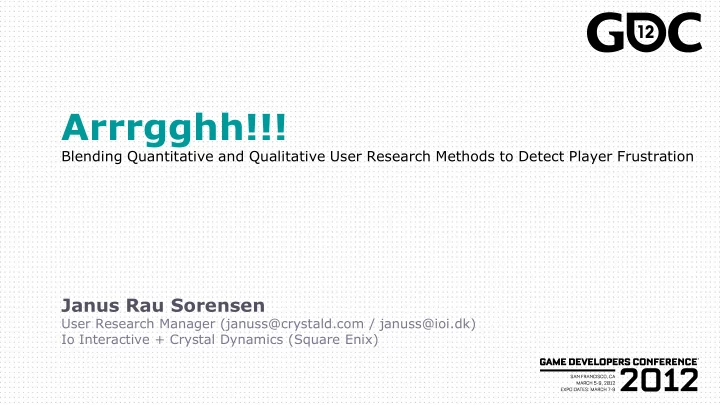

Arrrgghh!!! Blending Quantitative and Qualitative User Research Methods to Detect Player Frustration Janus Rau Sorensen User Research Manager (januss@crystald.com / januss@ioi.dk) Io Interactive + Crystal Dynamics (Square Enix)
User research Interviews Field work Surveys Heuristics Observation Biometrics Usability test Gameplay metrics Participatory design
Frustration An emotional state that arises as a response to a perceived opposition towards the achievement of a goal Frustrations are part of an enjoyable life … but not all frustration is enjoyable
What doesn't kill you Makes you stronger Sucks
Internal user research team, small facilities, small sample sizes ( ≈6 -8 per test) Qualitative research was solid Game telemetry analysis did not add much Cooperation with ITU was inspiring but seldom useful in a development context
One day Died repeatedly in a random Increasingly rushed forward playsession Paid less and less attention to his surroundings Finally, the player took his time to figure out a way through using a workaround, but he was not satisfied General frustration pattern from everyday life
Perceived frustrating experience Errors Stress Poor play Lack of focus performance
The approach Qualitative observations of participant Qualitative hypothesis (observation and video analysis) forming Identification of quantitative markers Quantitative correlated to behavior (metrics analysis and hypothesis translation mathematical model formulation) Detection of specific quantitative markers in Quantitative verification other players (SQL query) Qualitative Qualitative verification (interviews) verification
Analysis of recorded session video Further analysis of the playsession session (video/capture) to refine the symptoms of frustration
Gameplay metrics analysis The player dies in the same location several consecutive times in a short span. The number of enemies killed decreases considerably in each playthrough. The pace of movement of the player becomes considerably faster in each playthrough, and the same route is repeated with little or no variation. Lacking the presence of special events such as triggering environment explosions or picking up weapons dropped by enemies. Higher coincidence of camera vector (where is the player looking at) with character vector (in which direction is the player moving).
The model Timestamp (t) . The timestamp is • set to zero the moment a new playsession begins. <tf> describes a time interval that has been identified as “frustrated” tn <tf<tn+1 Number of player’s deaths (Pd) , • Pd>=2 <Pdl> expresses the distance between player deaths in world units 0<Pdl<20 Player’s pace of movement (Pm) • Pmf>Pm measured as distance in space travelled in one second, averaged for NPCd(tfn+1)<NPCd(tfn) the whole playsession. <Pmf> WApu(tfn+1)<WApu(tfn) defines the average pace of player movement during an interval of time identified as “frustrated” All conditions Number of NPCs killed (NPCd) • need to apply Number of weapons or ammo • picked up (Wapu)
Experimentation ● Game metrics data from 22 randomly selected players was analyzed, looking for the pattern that was individuated as potentially causing frustration. (SQL query) ● Identification of behaviors, similar to the one observed previously, in six cases; on different levels of the game
Follow-up interviews Follow-up interviews 22 sampled players ● Open-ended interviews ● Retrospective think-aloud (video ● recordings/metrics replay) Results The same six players whose patterns of behavior ● were found to carry the markers of frustration identified earlier confirmed that they felt frustrated at those times during their play sessions. None of the remaining 16 players felt frustrated ●
Conclusions + Promising model to detect unwanted frustration + Successful interface between ! The model presented is tied to KL2 industry and academia ! Frustration can be manifested in + Easy re-insertion into practice behavior in many ways + Successful interface between ! May depend on type of personality quantitative and qualitative ! Not about magnitude of frustration methodologies ! Doesn’t tell you why + Useful with small sample sizes before release ! Does not make researchers obsolete + Systems theory can be used on ! Doesn’t mean that vicious cycles both individuals and the social should be avoided, just managed
Acknowledgements IT University of Copenhagen ● ● Dr. Alessandro Canossa ● Everyone from the Kane & Lynch 2 team at Io Interactive and the Eidos Online group
Janus Rau Sorensen januss@crystald.com / januss@ioi.dk
Recommend
More recommend